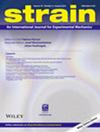纸板在连续拉伸加载过程中的微观变形机制和4D同步加速器X射线断层扫描
IF 1.8
3区 材料科学
Q2 MATERIALS SCIENCE, CHARACTERIZATION & TESTING
引用次数: 5
摘要
更好地了解纸板材料变形和失效背后的中尺度和微观机制,对于优化工业包装转化过程和减少浪费非常重要。在本研究中,使用同步加速器X射线断层扫描在原位连续单轴拉伸加载过程中研究了这些机制。高的空间和时间数据分辨率能够量化材料失效之前、期间和之后发生的材料快速变化。三维应变场、纤维取向和样品厚度的演变表明,在机器方向(MD)、横向(CD)和与加载方向成45°测试的样品之间,变形和失效机制存在显著差异。在45°和CD中,可以在几个加载步骤中遵循逐渐失效过程。失效后,与MD相比,45°和CD的平面内断裂区域明显更大。三个材料方向之间的断裂特征和应变场分布都不同。从加载开始,显著的纤维重新定向就已经是45°的一种主动变形机制,在峰值加载后的CD中也存在,但在MD中不存在。本研究中在纤维网络规模上解释和量化的MD相关机制有助于指导模型开发,并可能对其他纸基材料具有更广泛的适用性。本文章由计算机程序翻译,如有差异,请以英文原文为准。
Microscale deformation mechanisms in paperboard during continuous tensile loading and 4D synchrotron X‐ray tomography
A better physical understanding of mesoscale and microscale mechanisms behind deformation and failure of paperboard material is important to optimize industrial packaging converting processes and decrease waste. In this study, these mechanisms were investigated using synchrotron X‐ray tomography during in situ continuous uniaxial tensile loading. High spatial and temporal data resolution enabled quantification of rapid changes in the material occurring before, during and after material failure. The evolution of 3D strain fields, fibre orientations and sample thickness showed that deformation and failure mechanisms differ significantly between samples tested in machine direction (MD), cross direction (CD) and 45° from the loading direction. In 45° and CD, gradual failure processes could be followed across several load steps. Immediately after failure, the in‐plane fracture region was significantly larger in both 45° and CD compared to MD. Both fracture characteristics and strain field distributions differed between the three material directions. Significant fibre reorientation was an active deformation mechanism in 45° already from the beginning of the loading, also present in CD after peak load but absent in MD. The MD‐dependent mechanisms interpreted and quantified at the scale of the fibre network in this study can help guide model development and likely have wider applicability to other paper‐based materials.
求助全文
通过发布文献求助,成功后即可免费获取论文全文。
去求助
来源期刊

Strain
工程技术-材料科学:表征与测试
CiteScore
4.10
自引率
4.80%
发文量
27
期刊介绍:
Strain is an international journal that contains contributions from leading-edge research on the measurement of the mechanical behaviour of structures and systems. Strain only accepts contributions with sufficient novelty in the design, implementation, and/or validation of experimental methodologies to characterize materials, structures, and systems; i.e. contributions that are limited to the application of established methodologies are outside of the scope of the journal. The journal includes papers from all engineering disciplines that deal with material behaviour and degradation under load, structural design and measurement techniques. Although the thrust of the journal is experimental, numerical simulations and validation are included in the coverage.
Strain welcomes papers that deal with novel work in the following areas:
experimental techniques
non-destructive evaluation techniques
numerical analysis, simulation and validation
residual stress measurement techniques
design of composite structures and components
impact behaviour of materials and structures
signal and image processing
transducer and sensor design
structural health monitoring
biomechanics
extreme environment
micro- and nano-scale testing method.
 求助内容:
求助内容: 应助结果提醒方式:
应助结果提醒方式:


